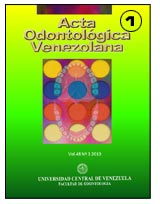RESISTENCIA A LA FRACTURA DE PREMOLARES TRATADOS ENDODÓNTICAMENTE, RESTAURADOS CON DOS SISTEMAS DE PERNOS Y NÚCLEO
Keywords:
Resistencia a la fractura, patrón de fractura, dientes tratados endodónticamente, Sistema de perno y núcleo, perno prefabricados de fibra de vidrio, pernos colados, Fracture resistance, endodontically treated teeth, prefabricated fiber glass posts, customAbstract
Objetivos: Medir la resistencia a la fractura en premolares tratados endodónticamente, restaurados condos sistemas de pernos (Colados/ Prefabricados) y analizar el patrón de fractura que se produce en laraíces. Materiales y Métodos: a 60 premolares humanos monorradiculares se les realizó la terapiaendodóntica. Se dividió la muestra aleatoriamente en dos grupos (30 c/u), el grupo 1 (G1FV) se restaurócon pernos prefabricados de Fibra de Vidrio (Ángelus®) y el grupo 2 (G2C) con pernos colados dealeación base (Orca Plus /Ventura), utilizando cemento resinoso Nexus 2 (Kerr), los 2/3 coronales deambos grupos fueron restaurados con resina compuesta híbrida (Glacier A1/ SDI). Las muestras fueroncargadas a una velocidad de 2mm/min y a una angulación de 30° con el eje longitudinal del diente en lamáquina de prueba universal (Shimadzu AGS- J), la resistencia a la fractura fue medida en newtons yanalizada con ANOVA de una vía; por medio de la observación directa y Rx se determinó el patrón defractura que fue analizado con X² y Prueba Z. Resultados: En relación a resistencia a la fractura no hubodiferencia estadísticamente significativa entre los grupos (p=0,741). En cuanto al patrón de fractura seobservó diferencia estadísticamente significativa entre los grupos estudiados (Zc=4,47). Conclusiones:En las condiciones en las que se realizó esta investigación se observó que los dos sistemas de perno ynúcleo resisten de manera similar a las tensiones inducidas. En cuanto al patrón de fractura radicular enel G1FV se producen menor número de fracturas no reparables cuando se compararon con el G2C.
Fracture resistance in endodontically treated premolars restored with two systems of posts.
Summary:Objective: The purpose of this research was to compare the fracture resistance of human premolarsrestored with prefabricated fiber glass posts and custom cast post and to analyze the nature of the rootfracture patterns. Methods: 60 human monoradicular premolars were prepared with endodontic therapyand randomly assigned to one of two groups: group 1 (G1FV) recovered with prefabricated fiber glassposts (Ángelus) or group 2 (G2C) with custom cast base alloy posts (Orca /Ventura Extra) using resinousluting cement (Nexus2/Kerr). 2/3 of the crowns were restored with hybrid composite (Glacier A1/SDI).The samples were loaded at a speed of 2mm/min and to a 30° angulation with the longitudinal axis of thetooth in the universal testing machine (Shimadzu AGS- J).The fracture resistance was recorded andanalyzed with one way ANOVA. The nature of the root fracture patterns was determined through directobservation and Rx; these data were analyzed with X² and Z test. Results: After the ANOVA analysis nostatistically significant differences were observed in relation to fracture resistance between groups (p =0,741). However, significant differences were found for the nature of the root fracture between thegroups (Zc=4, 47). Conclusions: Under the conditions of this study, both systems of posts have asimilar fracture resistance. In relation to root fracture patterns, there are less catastrophic fractures inthe G1FV when compared to G2C.

